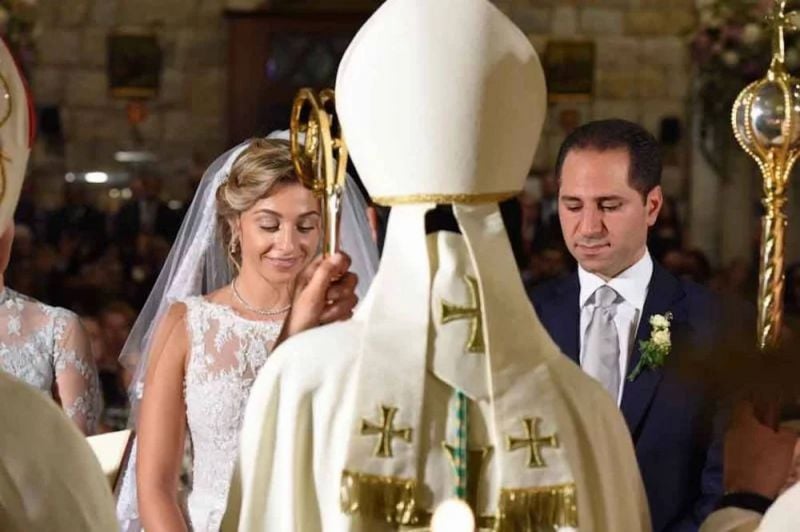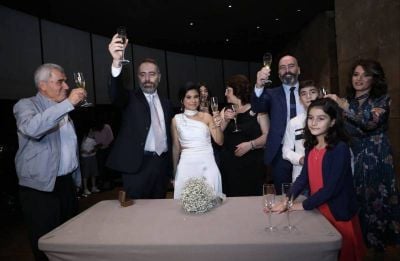
The marriage of Sami Gemayel and Carine Tadmouri. (Credit: Dalati and Nohra)
The marriage of Ghassan Tueni (Greek Orthodox) to Nadia Hamadeh (Druze) in 1954 caused a stir among the bride’s co-religionists, who were less open to interfaith marriages.
A few decades later, however, two mixed marriages were seen in the Joumblatt family. Taymour married Diana Zeaiter (Shia), while his sister Dalia got married to Joey Daher (Maronite). This double transgression of norms reflects a certain flexibility in mores, but does not mean it will be tolerated as general practice.
“Mixed [marriages] are particularly frowned upon within the Druze community, which fears seeing itself diluted,” said Karim Bitar, a political scientist. Kamal Joumblatt, an avowed socialist, had himself tried to lead the way a few decades ago, saying that “as long as Christians and Muslims do not marry from each other, national unity will never be achieved.”
Within the political class, several inter-faith marriages were concluded in recent years. Sami Gemayel, grandson of the founder of the Kataeb Party, Pierre Gemayel — a party with a solid Christian following — married Carine Tadmouri (Sunni from Tripoli). Tony Frangieh, son of Marada leader Sleiman Frangieh, is married to Lynn Zeidan (also Sunni), daughter of Mohammad Zeidan, a well-known businessman.
“Sami Gemayel has only taken half a step towards changing mentalities,” said Mona Fayad, a professor of social psychology. The marriage between the Kataeb leader and Carine Tadmouri only took place after she converted to Christianity.
In Zgharta, the marriage of the Frangieh family’s heir was only criticized “by our political opponents,” he told L’Orient-Le Jour, saying this marriage was facilitated by the fact that he grew up in “a religious environment [albeit] one steeped in secularism.” Frangieh’s father remarried, defying [the increasingly challenged] prohibitions related to Maronite marriage. As a result, he said, Sleiman Frangieh “did not object” to his son’s marriage to a Muslim woman, similar to those around him.
“It must be said that I attended the Lycée Français in Tripoli, surrounded by a majority of Sunnis,” he told L’Orient Le-Jour, although he met his wife at university in London.
Mixed marriage and secularism
Mixed marriages are legion within the ranks of Change MPs. Marc Daou (Druze) recently married Christiana Parreira (Christian), Michel Doueihy (Maronite) is married to Sobhia Najjar (Shiite) and Paula Yacoubian’s first husband, Mouaffak Harb, is Shiite.
They cannot be considered as non-conformist examples, especially given that these young MPs claim to be part of a reform movement.
“The social repercussions of mixed marriages are not the same as they were in my parents’ generation. There is more and more respect for the personal choices of young couples,” said Marc Daou.
“From the outset, the MPs emanating from the uprising did not see themselves as coming from a particular [religious] community. It’s not in their lexicon,” said Zeina Helou, activist and political researcher.
Are these few examples indicative of a wider trend? In the absence of statistics, it’s impossible to know. In a study published in 2008 by the French Institute of the Near East (IFPO), entitled “Breaking and following norms: Muslim-Christian couples in Lebanon,” Anne Françoise Weber, sociologist and journalist, pointed out that 15 years after the end of Lebanon’s Civil War, marriages between Christians and Muslims were still an exception rather than the norm.
Personal status matters are regulated by 15 separate personal status laws, all of which discriminate (to very different degrees) against women and children. Civil marriages are not performed in the country, but are recognized by the authorities when performed abroad. The many draft laws on civil marriage and on a unified Lebanese personal status code have come to nothing.
Only a few studies suggest trends, Weber noted, citing figures provided by researcher Bassam al-Hachem. The latter referred to a 1971 Family Planning Organization survey that revealed that of the 2,754 families surveyed, 91.3 percent of marriages were between people of the same faith, not only of the same religion (Christian or Muslim), but of the sect (Sunni, Shiite, Maronite, etc.).
The “challenges” to the social order were therefore already remarkable at the time. But mixed marriages later became even rarer during the Civil War, which enforced unprecedented community compartmentalization. “Mixed marriages were rather rare before and during the war,” said Bitar. “But there was already a certain social complicity among the elites of the different communities.”
‘Somewhat hypocritical’
Will Joumblatt, Gemayel and Frangieh set an example? It’s hard to say at the moment. Because what is allowed in a class that has money and power is not necessarily allowed among less privileged classes.
“It’s often children of wealthy families who enjoy more freedom than others and can easily defy social norms. Unless the mentality is extremely conservative,” said Fayad.
“This can be perceived as somewhat hypocritical, when the zaim exempts himself and his family from the norms that apply to other Lebanese,” said Bitar.
Helou noted that despite the mix sought through these marriages, the political discourse has not changed and remains impregnated with a sectarian tone, all the more so as the election of these MPs continues to be based on sectarian principles. Even if the zaim had wanted to set an example, given the current state of affairs — the laws in force and the sectarian personal statutes that dictate social norms — there are many obstacles to any attempt to follow the path of modernity.
“As long as these young MPs do not go so far as to loudly and clearly advocate for mixed marriage,” said Bitar, “to no longer be the exception, and do not work actively to institutionalize civil marriage, we cannot yet talk of a real change in mentality.”
This story was originally published in French in L’Orient-Le Jour. Translation by Joelle El Khoury.
